Southbank Centre: Difference between revisions
No edit summary |
|||
| Line 56: | Line 56: | ||
In March 2013 the Southbank Centre unveiled plans, which soon became a source of vigorous debate, for alterations to the Hayward and Queen Elizabeth Hall dubbed the "Festival Wing", funded by Arts Council England. The proposal would have provided arts spaces in a new high level L-shaped building linking the Hayward Gallery and Purcell Room buildings and with a wing running parallel to Waterloo Bridge behind the Queen Elizabeth Hall auditorium. Its features were to include a glass pavilion, new arts spaces, a literature centre, cafés and commercial units. | In March 2013 the Southbank Centre unveiled plans, which soon became a source of vigorous debate, for alterations to the Hayward and Queen Elizabeth Hall dubbed the "Festival Wing", funded by Arts Council England. The proposal would have provided arts spaces in a new high level L-shaped building linking the Hayward Gallery and Purcell Room buildings and with a wing running parallel to Waterloo Bridge behind the Queen Elizabeth Hall auditorium. Its features were to include a glass pavilion, new arts spaces, a literature centre, cafés and commercial units. | ||
The proposed alterations would have replaced the skate park which has developed in the [[Queen Elizabeth Hall#The Undercroft|undercroft]], hailed as the birthplace of British skateboarding, with retail units to fund the new arts spaces.<ref>'[https://www.theguardian.com/uk/2013/apr/12/skateboarding-south-bank?CMP=twt_gu Skateboarding's South Bank home to be turned into retail units]' - Roxanne Escobales in ''The Guardian'' 12 April 2013<ref>'[http://www.vice.com/en_uk/read/shutting-down-south-bank-skate-park Why Closing Southbank Skate Park Would Suck for London]': Clive Martin in ''Vice'' magazine April 2013</ref> By May 2014, the campaign group strongly opposing the proposals called Long Live Southbank had gained over 120,000 members.<ref>'[https://www.theguardian.com/artanddesign/gallery/2013/may/11/skateboarders-fight-southbank-skate-park-closure-gallery Can skaters save their South Bank home?]': Killian Fox & Claire Hazelton in ''The Guardian'' 11 May 2013</ref> | The proposed alterations would have replaced the skate park which has developed in the [[Queen Elizabeth Hall#The Undercroft|undercroft]], hailed as the birthplace of British skateboarding, with retail units to fund the new arts spaces.<ref>'[https://www.theguardian.com/uk/2013/apr/12/skateboarding-south-bank?CMP=twt_gu Skateboarding's South Bank home to be turned into retail units]' - Roxanne Escobales in ''The Guardian'' 12 April 2013</ref><ref>'[http://www.vice.com/en_uk/read/shutting-down-south-bank-skate-park Why Closing Southbank Skate Park Would Suck for London]': Clive Martin in ''Vice'' magazine April 2013</ref> By May 2014, the campaign group strongly opposing the proposals called Long Live Southbank had gained over 120,000 members.<ref>'[https://www.theguardian.com/artanddesign/gallery/2013/may/11/skateboarders-fight-southbank-skate-park-closure-gallery Can skaters save their South Bank home?]': Killian Fox & Claire Hazelton in ''The Guardian'' 11 May 2013</ref> | ||
In early September 2013, the Southbank Centre published three alternative design options (developed by SNE Architects, 42 Architects and Rich Architects) for a proposed new purpose designed skateboarding area under Hungerford Bridge, 130 yards to the south near Jubilee Gardens.<ref>'[http://www.itv.com/news/london/update/2013-09-09/designs-unveiled-for-southbank-centre-skate-space/ First glimpse at plans for Southbank Centre skate space]': ITV News 9 September 2013</ref><ref>'[http://www.caughtinthecrossfire.com/skate/southbank-centre-releases-design-for-new-skate-park/ Southbank Centre releases design for new skate park]': ''Caught in the Crossfire'', 9 September 2013</ref><ref>'[http://www.bbc.co.uk/news/uk-england-london-24022025 Southbank development: Designs for new skatepark released]': BBC News 9 September 2013</ref> | In early September 2013, the Southbank Centre published three alternative design options (developed by SNE Architects, 42 Architects and Rich Architects) for a proposed new purpose designed skateboarding area under Hungerford Bridge, 130 yards to the south near Jubilee Gardens.<ref>'[http://www.itv.com/news/london/update/2013-09-09/designs-unveiled-for-southbank-centre-skate-space/ First glimpse at plans for Southbank Centre skate space]': ITV News 9 September 2013</ref><ref>'[http://www.caughtinthecrossfire.com/skate/southbank-centre-releases-design-for-new-skate-park/ Southbank Centre releases design for new skate park]': ''Caught in the Crossfire'', 9 September 2013</ref><ref>'[http://www.bbc.co.uk/news/uk-england-london-24022025 Southbank development: Designs for new skatepark released]': BBC News 9 September 2013</ref> | ||
Latest revision as of 19:14, 6 June 2017
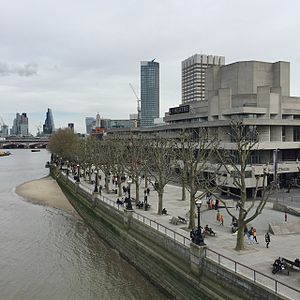
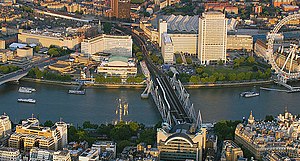
The Southbank Centre is a complex of artistic venues in standing along the south bank of the River Thames in Lambeth, Surrey, between Hungerford Bridge and Waterloo Bridge.
The centre comprises three main performance venues and an art gallery:
- The Royal Festival Hall (including the Saison Poetry Library)
- The Queen Elizabeth Hall;
- The Purcell Room
- The Hayward Gallery
Together they make up Britain's largest centre for the arts, and a complex larger than any in Europe. It attracts more than six million visitors annually. Over two thousand paid performances of music, dance and literature are staged at Southbank Centre each year, as well as over two thousand free events and an education programme,[1] in and around the performing arts venues.
In addition, three to six major art exhibitions are presented at Hayward Gallery yearly, and National Touring Exhibitions reach over 100 venues across the United Kingdom.
Location
- Location map:51°30’21"N, 0°7’0"W
The Southbank Centre's site is fronted by The Queen’s Walk along the riverside. Formerly the estate extended to 21 acres from County Hall to Waterloo Bridge, but in 2012 management of the Jubilee Gardens was transferred to the Jubilee Gardens Trust[2] and the car park on the remaining land beyond Hungerford Bridge was sold in 2013, to extend the gardens as part of the Shell Centre redevelopment.[3] The site is located next to the National Theatre and BFI Southbank, but does not include them.
The closest London Underground stations are Waterloo and Embankment, the latter across the river.
History
1950s

The history of Southbank Centre starts with the Festival of Britain, held in 1951. In what was described as "a tonic for the nation" by Herbert Morrison, the government minister responsible for the event, the Festival of Britain aimed to demonstrate Britain’s recovery from Second World War by showcasing the best in science, technology, arts and industrial design. It ran from May to September 1951, and by June the following year most of it had been dismantled. The Royal Festival Hall is the only building from the Festival of Britain that survives.
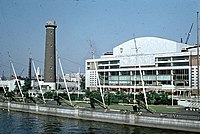
1960s
From 1962 to 1965, the Royal Festival Hall was extended towards the river and Waterloo station and refurbished. The Council decided in 1955 to build a second concert hall and an art gallery on the eastern part of the South Bank site previously occupied by a lead works and shot tower (and which had been earmarked as a site for the National Theatre).
It was another 12 years before the Queen Elizabeth Hall and the linked Purcell Room opened to the public. Together, they were to be known as South Bank Concert Halls. In 1968, the Hayward opened, under direct management of the Arts Council. While the Royal Festival Hall was built in a modernist style emphasising light and air, the 1960s buildings were built in a brutal, uncompromising, brutalist style, of bare, unadorned concrete.
The new buildings had their main entrances at first floor level and were integrated into an extensive elevated concrete walkway system linked to the Royal Festival Hall and the Shell Centre. This vertical separation of pedestrian and vehicle traffic proved unpopular due to the difficulty pedestrians had in navigating through the complex, and the dark and under-used spaces at ground level below the walkways.
1980s
Following abolition of the Greater London Council in 1986, the South Bank Board was formed to take over operational control of the concert halls. The following year, the South Bank Board took over the administrative running of the Hayward from the Arts Council. Collectively, the arts venues, along with Jubilee Gardens, became the South Bank Centre, responsible to Arts Council England as an independent arts institution.
1990s
The walkway on the east side of the RFH, running along Belvedere Road towards the Shell Centre was removed in 1999-2000, to restore ground level circulation. The Waterloo Site (the late 1960s buildings) has been the subject of various plans for modification or reconstruction, in particular a scheme developed by Richard Rogers in the mid-1990s which would have involved a great glass roof over the existing three buildings. This did not proceed due to the high degree of lottery funding required and likely high cost.
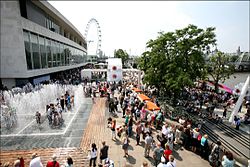
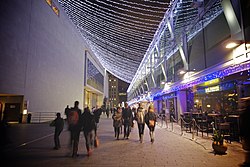
2000s
In 2000, a masterplan for the South Bank Centre site was produced. The main features were
- a new administration building for members of staff
- the removal of access for delivery vehicles to the south of the Hungerford Bridge approach viaduct and east of the Hayward (by Waterloo Bridge);
- the creation of three new public spaces around the RFH (Festival Riverside, Southbank Centre Square and Festival Terrace);
- modification of the Queen Elizabeth Hall undercroft and the lower two levels of the Hayward to provide a frontage onto Southbank Centre Square; and
- a new British Film Institute building partly underground on the Hungerford Car Park site.
In line with the plans, between 2004-7 a new glass-fronted building was created, providing office space for Southbank Centre staff, as well as a range of new shops and restaurants, was inserted between the RFH and the approach viaduct to Hungerford Bridge and along the low level Thames elevation of the Royal Festival Hall. Between 2005-7 the Festival Hall auditorium was modified, the natural acoustic enhanced to meet classical music requirements. Seating was also reconfigured, together with upgrades to production facilities and public areas, with provision of new bar areas, the removal of most shops from foyer spaces, refurbished lifts and WCs.
Festival Wing proposal
In March 2013 the Southbank Centre unveiled plans, which soon became a source of vigorous debate, for alterations to the Hayward and Queen Elizabeth Hall dubbed the "Festival Wing", funded by Arts Council England. The proposal would have provided arts spaces in a new high level L-shaped building linking the Hayward Gallery and Purcell Room buildings and with a wing running parallel to Waterloo Bridge behind the Queen Elizabeth Hall auditorium. Its features were to include a glass pavilion, new arts spaces, a literature centre, cafés and commercial units.
The proposed alterations would have replaced the skate park which has developed in the undercroft, hailed as the birthplace of British skateboarding, with retail units to fund the new arts spaces.[4][5] By May 2014, the campaign group strongly opposing the proposals called Long Live Southbank had gained over 120,000 members.[6]
In early September 2013, the Southbank Centre published three alternative design options (developed by SNE Architects, 42 Architects and Rich Architects) for a proposed new purpose designed skateboarding area under Hungerford Bridge, 130 yards to the south near Jubilee Gardens.[7][8][9]
Ultimately the scheme failed through opposition to cleaning up the undercroft and lack of funding.
"Let the Light In" scheme
Arts Council England awarded a £16m grant towards a two-year programme of repairs and conservation work on the Queen Elizabeth Hall, Purcell Room and Hayward Gallery in May 2014.[10] The refurbishment scheme was granted planning permission in May 2015.[11] The Southbank Centre has also received certain funding for the conservation and limited alteration scheme, known as "Let the Light In" from the Heritage Lottery Fund and is also raising funds from individuals for the final £3 million required. This more conservation orientated approach has also included joining with the National Trust to make the centre's 1960s buildings' contribution to the Brutalist movement better known.
Resident orchestras
The resident orchestras at Southbank Centre are:
- London Philharmonic Orchestra
- Philharmonia Orchestra
- London Sinfonietta
- Orchestra of the Age of Enlightenment
Outside links
| ("Wikimedia Commons" has material about Southbank Centre) |
- Southbank Centre
- www.concretecentre.org (Concrete Quarterly No. 72, 1968 including article on the South Bank Arts Centre - Hayward, Queen Elizabeth Hall and Purcell Room)
- The Long Live Southbank campaign
References
- ↑ Southbank Centre 2014-2015 Annual Report
- ↑ About the Gardens – Jubilee Gardens Trust
- ↑ 'Jubilee Gardens to be extended across Hungerford Car Park' – London-SE1.co.uk
- ↑ 'Skateboarding's South Bank home to be turned into retail units' - Roxanne Escobales in The Guardian 12 April 2013
- ↑ 'Why Closing Southbank Skate Park Would Suck for London': Clive Martin in Vice magazine April 2013
- ↑ 'Can skaters save their South Bank home?': Killian Fox & Claire Hazelton in The Guardian 11 May 2013
- ↑ 'First glimpse at plans for Southbank Centre skate space': ITV News 9 September 2013
- ↑ 'Southbank Centre releases design for new skate park': Caught in the Crossfire, 9 September 2013
- ↑ 'Southbank development: Designs for new skatepark released': BBC News 9 September 2013
- ↑ 'Southbank Centre in London gets £16m grant to carry out urgent repairs': Mark Brown in The Guardian 29 May 2014
- ↑ 'Feilden Clegg Bradley's Southbank refurb set to start in weeks': Jim Dunton in the Architects Journal 7 May 2015
